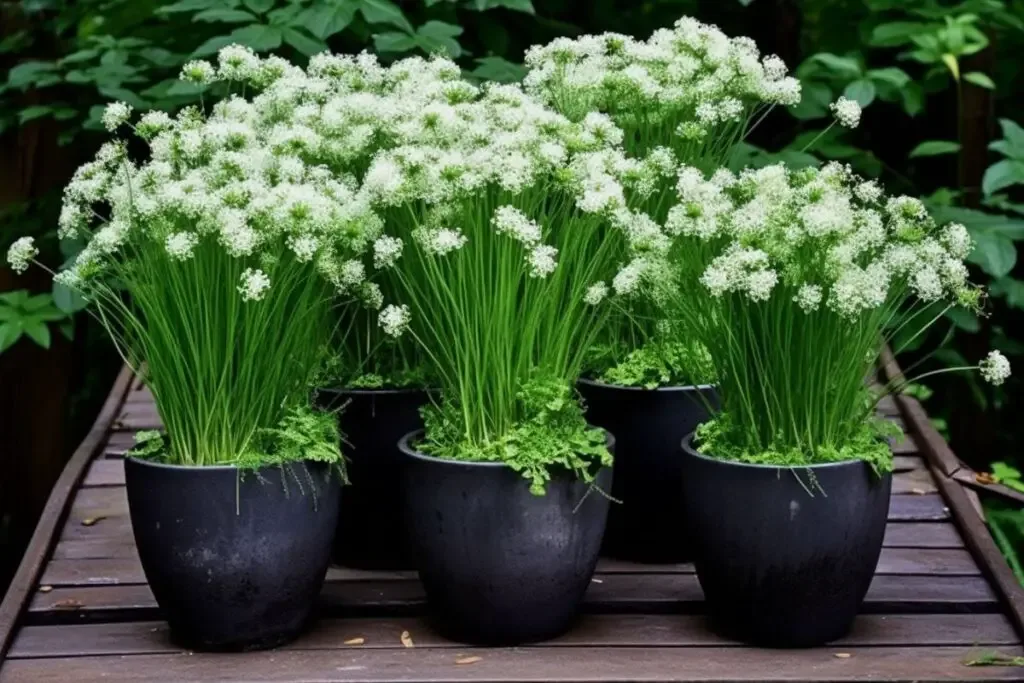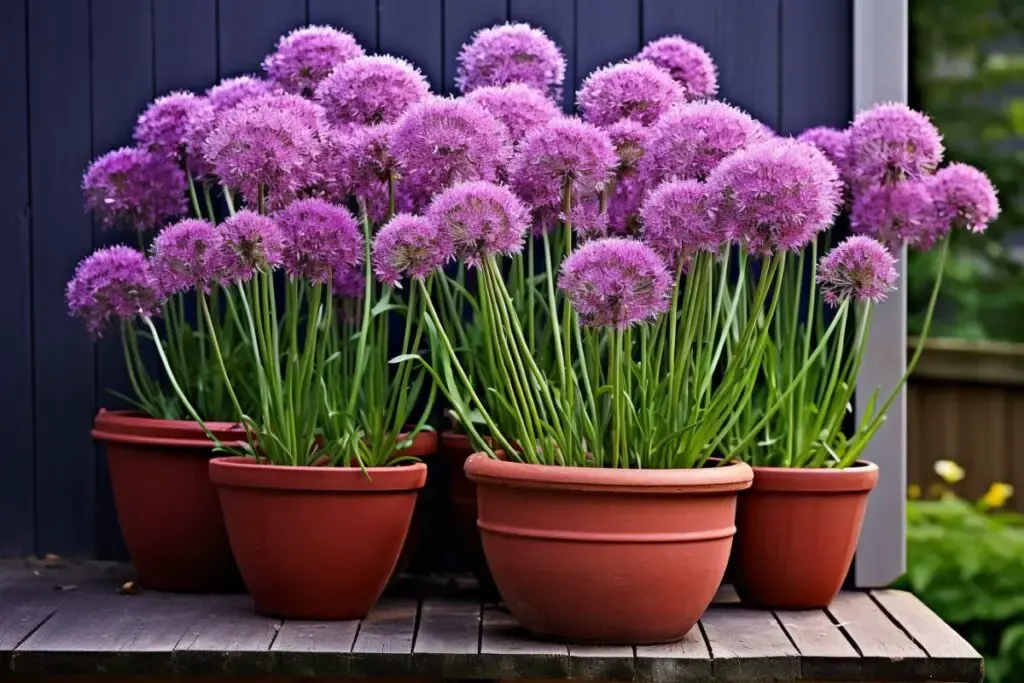Growing chives in pots is a delightful way to add a fresh, oniony flavor to your cooking year-round, and it’s something I’ve come to cherish in my own kitchen garden. These hardy little herbs are not only a culinary staple but also a charming green addition to any sunny windowsill or balcony.
As a gardening blogger with a penchant for practical and lush indoor greenery, I’m excited to share the joys of growing chives in containers.
With their minimal care requirements and high reward, chives are an ideal choice for both novice gardeners and seasoned green thumbs looking to expand their herb repertoire.
Does Chives Grow Well in Pots?
Absolutely, chives thrive in pots! One of the many beauties of chives is their adaptability. They don’t require the expanse of a garden bed, making them perfect candidates for container gardening.
Given the right conditions – adequate sunlight, well-draining soil, and a little TLC – chives will grace your pots with their slender leaves and perky purple flowers.
In pots, chives grow with a contained exuberance, and their modest root system means they don’t need deep soil to prosper. They’re also perennial, so if you care for them well, you’ll be rewarded with their presence year after year.
I’ve had chives in my kitchen that have become like old friends, returning each spring with renewed zest. When potted, these resilient herbs can be moved to chase the sun or to find shelter, ensuring they get just the right amount of light and warmth, no matter the season.
Moreover, growing chives in pots makes it easier to control moisture levels, protect them from extreme weather, and manage any unwelcome pests.
Best Chive Varieties for Pots
Selecting the right variety of chives for your container garden can be a flavorful journey. While most chives will happily grow in pots, there are a few varieties that particularly excel in container living.
1. Common Chives (Allium schoenoprasum)

Common chives are the variety most of us are familiar with. Their mild onion flavor makes them versatile in the kitchen, and their hardy nature makes them forgiving in the garden.
This variety is also known for its lovely lilac blooms that can add a pop of color to your pot and your salads. They tend to stay a manageable size, so you don’t need a large pot to keep them comfortable.
2. Garlic Chives (Allium tuberosum)

Garlic chives, also known as Chinese chives, boast a more garlicky flavor and are a must-have for fans of Asian cuisine. They have flat, broader leaves and white, star-shaped flowers that distinguish them from their common counterparts.
I find that they’re particularly robust and a touch more drought-resistant, which is a bonus if you’re sometimes forgetful with watering.
3. Giant Siberian Chives (Allium ledebourianum)

The Giant Siberian variety is a bit less common but just as easy to grow. These chives can get quite tall, offering a striking vertical element to your container garden.
Their blue-green foliage and large, ball-shaped purple flowers make them visually stunning. Because of their size, they might need a bit larger pot, but they’re worth it for the statement they make.
How to Grow and Care For Chives in Pots
Growing chives in pots not only saves on space but also allows for a closer, more personal interaction with your plants. Caring for them is relatively straightforward, but like all plants, they have their preferences.
Let’s dive into the specifics.
Planting
When planting chives, start with either seeds or divisions from an established plant. If you’re planting seeds, sprinkle them on top of the soil and lightly cover them with more potting mix; chive seeds need light to germinate.
For divisions, plant them at the same depth they were in their previous pot. Remember, chives are best planted in the spring after the last frost has passed or in the fall if you’re in a milder climate.
Pot Size
Chives aren’t picky about space, but they do appreciate a pot that’s at least 6-8 inches deep and wide to accommodate their clumping growth habit.
This gives them enough room to spread out and flourish without overcrowding. Ensure your pot has adequate drainage holes to prevent waterlogging, which chives are particularly sensitive to.
Light
Chives love sunlight. To mimic their natural habitat, place your potted chives in a spot where they can bask in at least six hours of sunlight a day. If you’re growing them indoors, a south-facing window is ideal. However, in very hot climates, they may appreciate a bit of afternoon shade to prevent scorching.
Soil
The key to the perfect soil for chives is good drainage. Opt for a loose, loamy potting mix that can hold moisture without becoming waterlogged. I like to mix in a bit of sand or perlite to ensure the soil is well-aerated, which encourages healthy root development.
Water
Chives growing in pots need consistent moisture, but they don’t like to sit in wet soil. Water when the top inch of soil feels dry to the touch. It’s a delicate balance—overwatering can lead to root rot while underwatering will leave your chives wilted and sad. I’ve found that a regular, even watering schedule works wonders.
Temperature and Humidity
Chives are pretty hardy and can tolerate a range of temperatures and humidity levels. They do best in moderate conditions but can survive light frosts, making them an excellent herb for cooler climates as well.
If the air gets too dry, especially indoors during winter, a pebble tray or occasional misting can help raise the humidity around your plants.
Fertilizer
While chives aren’t heavy feeders, they’ll benefit from a light application of a balanced, all-purpose liquid fertilizer every month during the growing season. I usually hold off on fertilizing in the winter when plant growth naturally slows down.
Organic options like compost or fish emulsion are great choices for keeping your chives happy and healthy, and they add to the overall sustainability of your gardening practices.
Pruning Potted Chives
Pruning is an essential part of growing chives, mainly for two reasons: it encourages fuller growth and prevents your chives from becoming too woody and sparse.
Chives are known for their resilience and respond well to regular trimming. As you use your chives, snip leaves from the outside of the clumps about 1-2 inches above the base of the plant. This method allows new, tender shoots to emerge, keeping your plant lush and bushy.
Don’t be afraid to give your chives a good haircut. In fact, cutting them back hard can often rejuvenate an older plant that’s started to slow down in production. I find that more substantial pruning right before the flowering stage redirects the plant’s energy to produce more leaves instead of flowers and seeds.
However, if you enjoy the delicate purple flowers that chives produce, feel free to leave a few stems to bloom; they’re edible too, and can add a splash of color to salads.
Overwintering
Overwintering chives in pots is fairly straightforward, as they are a hardy perennial. In areas with mild winters, chives can often be left outside. If you live in a region with harsh winters, you’ll want to protect your potted chives from the freezing temperatures.
One option is to bring the pots indoors before the first frost. Place them in a cool, bright spot, like a sunny windowsill, and reduce watering since the plants will be in a semi-dormant state.
If indoor space is an issue, you can also overwinter chives by mulching heavily over the pot or burying the pot in the ground up to the rim to insulate the roots. Just remember to uncover them in the spring.
If your chives do stay outside, they may die back and look quite forlorn during the coldest months, but don’t worry—this is natural.
As the days lengthen and temperatures rise, new growth will typically sprout from the soil with vigor. I often take this opportunity to divide and repot my chives, refreshing the soil and giving them more space to grow as the new season begins.

